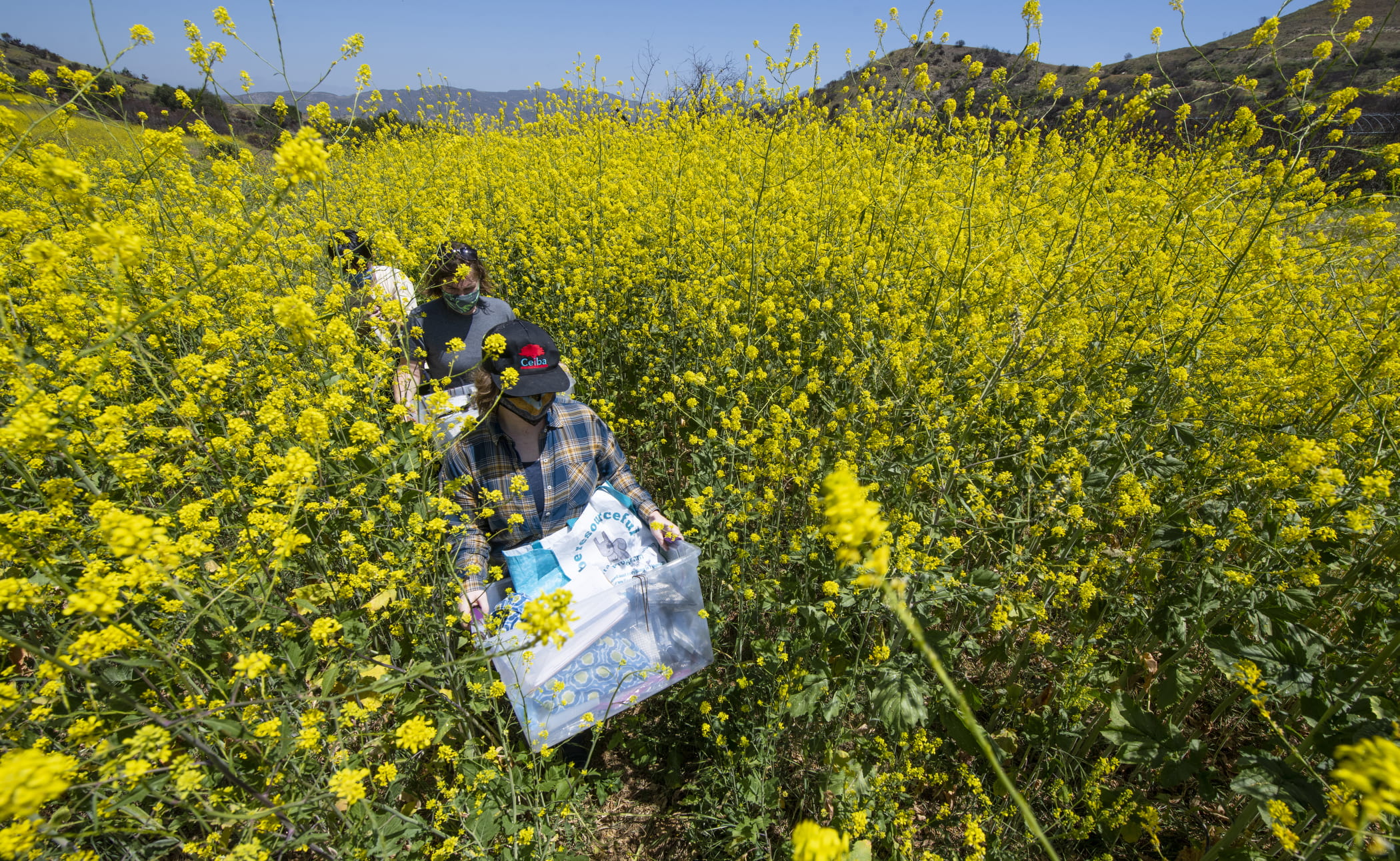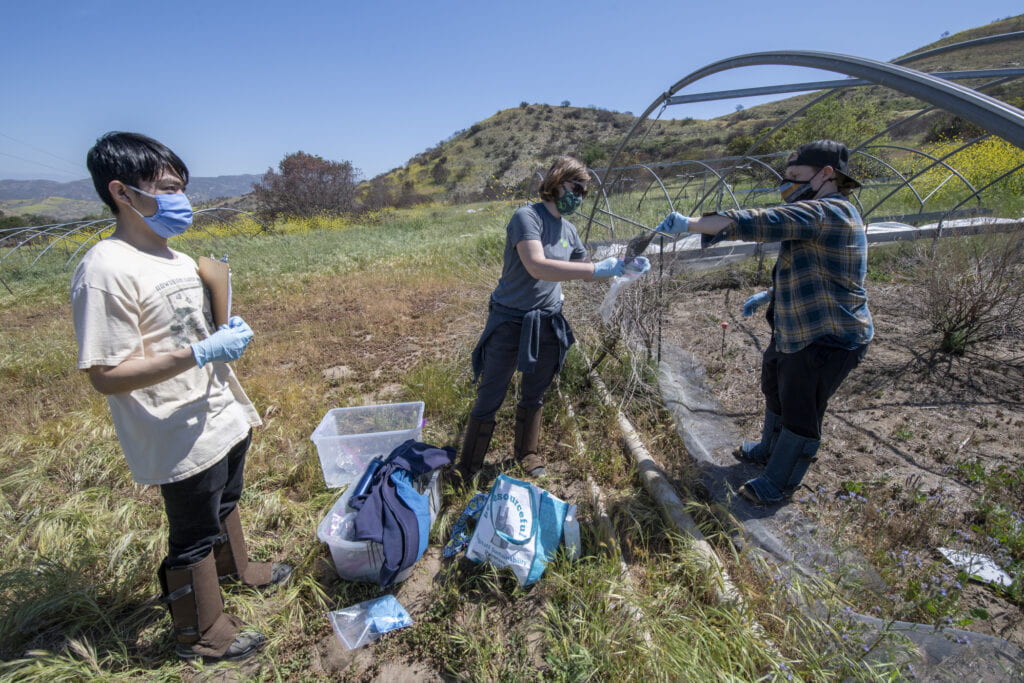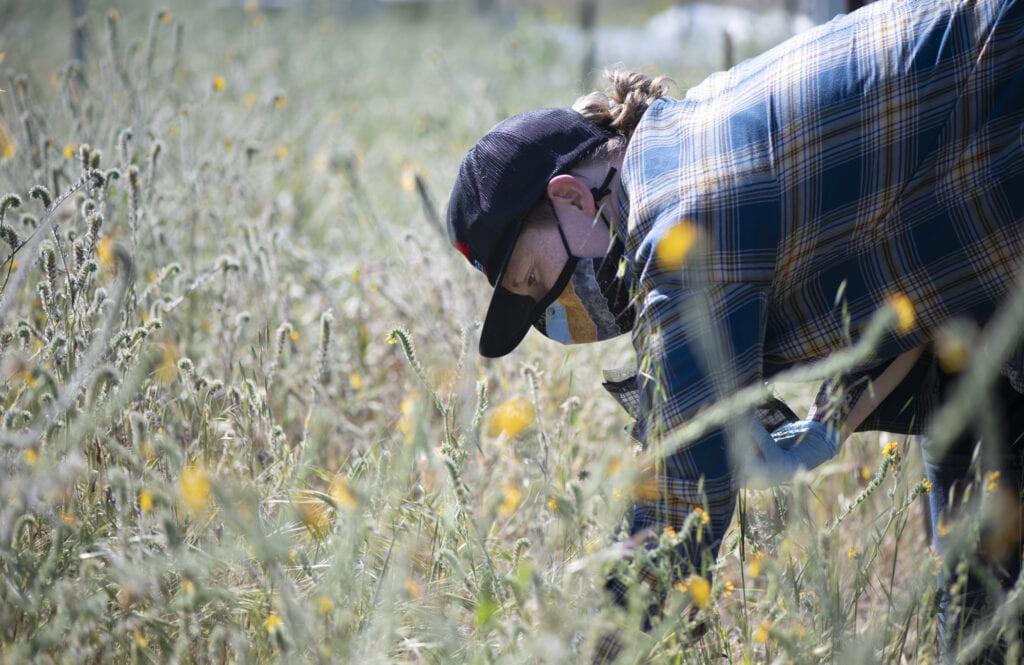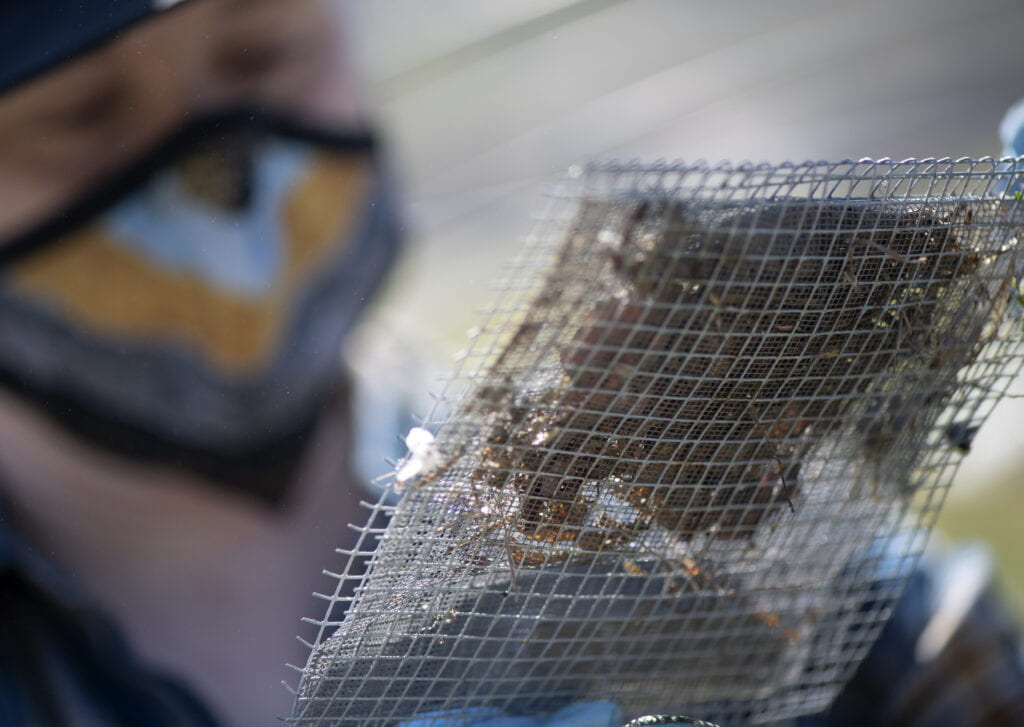Fieldwork for a better future
UCI partners with Irvine Ranch Conservancy for climate change adaptation study of plant and microbial ecosystems on Loma Ridge

Off a gravel road in the hills east of Irvine and down a barely navigable footpath through dense stands of head-high, bright yellow mustard plants, a series of arched metal frames indicates several research plots.
Here at Loma Ridge, near the 241 toll road, UCI scientists are studying how plant and microbial ecosystems will respond to increasingly severe droughts and hotter temperatures driven by climate change. They’re also examining how local ecosystems recover from wildfire – the 2007 Santiago fire and the 2020 Silverado fire both swept through here – among other questions.
UCI researchers manipulate environmental conditions at each research plot. Some receive nitrogen fertilizer, to mimic the way that car exhaust and other pollution sources deposit extra nitrogen in the hills. Some are deprived of water by tarps that must be rolled out over the arches when rain is forecast.
On a recent spring day, Bri Finley, a UCI postdoctoral scholar in ecology & evolutionary biology, crouched beneath one of the tunnel-like metal frames in a research plot simulating drought and worked to dislodge a 6-inch-square white packet from shoots of grass and stalks of weeds that had grown up and trapped it there. Months earlier, in late December 2020, Finley had placed this packet and dozens like it in eight plots across the hillside, which was bereft of vegetation at the time. Now it was covered with grasses and shrubs.
Inside every packet is a curated microbial community plus a carefully measured amount of sterilized leaf litter and other plant detritus – food for the microbes. Half of the packets are made of a white nylon material that allows only water, nutrients and air to pass through miniscule pores, trapping bacteria and microbes inside. The other half are made of a mesh that resembles a window screen.
Finley and two assistants were here to collect a quarter of the packets and bring them back to the lab for analysis. The rest will be retrieved in three additional batches over the course of the two-year experiment, which will enable scientists to better understand how soil microbes respond to various drought conditions that will become increasingly prevalent due to climate change. With this knowledge in hand, land managers can help local ecosystems adapt.

Finley managed to extract the first packet from the plant roots that had entrapped and buried it. More followed. Finley read off the tags identifying the packets as UCI undergraduate Brian Chung, who was holding a clipboard, marked off the information. The sealed white packets went directly into a plastic bin for transport; the open mesh ones were dropped into zip-close bags before joining them.
“And can you note that it’s half-buried? Because if it’s covered in soil, that’s got to affect moisture and shading,” Finley said.
A hawk’s cry cut through the steady chirping of birds. Periodically, Finley spritzed their latex-gloved hands with ethanol to prevent cross-contamination.
Partners in science and conservation
Loma Ridge and the land around it is owned by OC Parks and managed by the Irvine Ranch Conservancy, which stewards roughly 30,000 acres in Orange County that were formerly part of the Irvine Ranch. UCI scientists have collaborated for years with the IRC on various research projects in multiple locations, but Loma Ridge is the largest.
All three organizations benefit from the partnership.
The advantage to the conservancy is that UCI’s research capacity and focus on answering foundational scientific questions produce knowledge that informs land management decisions. UCI gains access to an enormous, well-tended outdoor laboratory. And OC Parks gets restored habitats within its nature preserves.
“In the partnership with UCI, what we can often provide is material support, logistical support, help with management of the sites,” says Nathan Gregory, IRC vice president and chief programs officer. “But when it comes to much of the actual data collection and analysis, that’s when the academic partners come in.”
The conservancy employs a method of adaptive land management that relies heavily on data collection and environmental monitoring to assess what’s working, what isn’t and what needs to change.
For instance, Gregory says, conventional wisdom held that cattle grazing drove habitat decline and that after removing cattle, native ecosystems would bounce back. But that hasn’t happened. Instead, regions that should be shrubby continue to turn into grasslands dominated by invasive annual plant species, even without grazing. Fire that’s too frequent is one of the major contributors to this type of habitat conversion.
“The research has really helped us understand the trajectory of some of these areas,” Gregory says. “A long-term investment in vegetation monitoring and other studies by multiple partners has indicated that a passive approach doesn’t work under these conditions.”
Ongoing research projects conducted by UCI and the conservancy at Loma Ridge rely on collecting and analyzing data to monitor habitat quality and assess restoration of ecosystems, including at burn locations, in stands of oak trees, and at sites where relocated soil packed with native seeds has been added to bolster the native seed bank.
A climate change adaptation study was first launched at Loma Ridge in 2006, led by UCI Earth system science professor Mike Goulden, to see how the local ecosystem responds to excess rain as well as drought. In 2010, Goulden was joined by Steven Allison, a UCI professor of ecology & evolutionary biology. Since then, the U.S. Department of Energy has awarded Allison’s team a series of grants for studies at Loma Ridge on how soil microbes respond to drought. The latest, in 2019, was for $2.7 million and covers the research conducted by Finley.
Research bonanza
Other professors are also conducting research at Loma Ridge. Data is continually collected on temperature fluctuations; wind patterns; types of plants; the levels of pH, carbon and nitrogen in the soil; and other things. Dozens of scientific studies have been published based on experiments at Loma Ridge looking at topics such as how microbe diversity relates to plant diversity, how microbes respond to drought and how ecosystems recover after fires.
“We work closely with the Irvine Ranch Conservancy and share our results with them to see if we can make these systems more resilient to climate change, more resilient to fire, if there’s a way we can manage for endangered species or for pollution,” Allison says.
At any given time, 15 to 20 UCI students, postdoctoral researchers and staff are working on experiments related to Loma Ridge, and somebody from UCI is at the site almost every day, especially in springtime.
On that bright April day, between bouts of wresting microbe packets from the dirt, Finley held up a tangle of plant roots. “These form a really important area of the soil called the rhizosphere. The plant roots will shoot carbon into the soil,” Finley said. “Just on this little clump of roots, there are probably a billion microbes hanging out.”

“And the fungi really like it,” added Andie Nugent, a UCI Ph.D. student in ecology & evolutionary biology.
Soil microbes have a dual effect on levels of atmospheric carbon dioxide. When conditions are good and there is plenty of water, they flourish and respire, releasing carbon dioxide gas into the air. Simultaneously, they cycle the nutrients that plants need to grow – growth that traps carbon as organic matter. When conditions are poor and there is a drought, microbes hunker down, respire less and release less carbon dioxide gas. But they also cycle fewer nutrients, inhibiting the growth of plants that might otherwise trap carbon in the soil.
Finley’s research will help scientists understand how these feedback loops will play out as climate change heats up the planet, as well as determine if microbes can adapt to shifting conditions.
“Microbes mediate a lot of that movement of carbon from the atmosphere to the soil, so understanding their behavior and how they respond to future climate changes – like drought and temperature changes – can help us predict whether the soil will be a source of CO2 into the atmosphere in the future or might help trap some of that CO2 for us,” Nugent said.
Next steps
With the packets collected from the first of eight plots, the group moved on to the second plot, an ambient, or unaltered, one. Compared to the drought plot, the grasses and shrubs there were much lusher – and the packets even more challenging to extract, entangled in the roots and stems of purple and yellow flowers.

After the field expedition, the team – with 10 volunteers – planned to take the packets back to the lab, sort them by plot, weigh the leaf litter in each packet, put the litter through a coffee grinder and spend two weeks collecting data. They would measure the mass of litter lost to microbe consumption during the months of exposure to the elements. They’d use lab equipment to sequence the microbial DNA to assess the microbial composition of each sample. And they would determine the microbes’ level of activity by gauging the quantity of enzymes – proteins that microbes release into the soil to break down and digest leaf litter food – in the samples.
After the eighth and final plot, two packets were still missing. The team doubled back to a prior plot to search for them. The researchers found one overlooked packet and turned to another grassy patch to locate the second.
“My guess is that gophers loosened the soil and then some wind blew it out,” Nugent said.
“There were some really bad Santa Ana winds shortly after I deployed the packets, and there was so little vegetation,” Finley said.
These are the vagaries of the kind of scientific fieldwork that has real-life relevance to plants, animals, ecosystems and the people linked to them. Conditions can’t be controlled precisely. Unforeseen circumstances arise. And uncontrollable critters can wreak havoc.
“One lost packet isn’t so bad,” Nugent said.
If you want to learn more about supporting this or other activities at UCI, please visit the Brilliant Future website. Publicly launched on Oct. 4, 2019, the Brilliant Future campaign aims to raise awareness and support for UCI. By engaging 75,000 alumni and garnering $2 billion in philanthropic investment, UCI seeks to reach new heights of excellence in student success, health and wellness, research and more. The School of Biological Sciences plays a vital role in the success of the campaign. Learn more by visiting https://brilliantfuture.uci.edu/school-of-biological-sciences.


